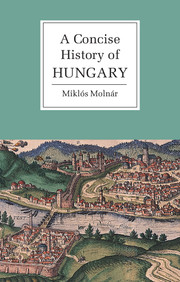Book contents
- Frontmatter
- Contents
- List of illustrations
- Acknowledgements
- Chronology
- 1 FROM THE BEGINNINGS UNTIL 1301
- 2 GRANDEUR AND DECLINE: FROM THE ANGEVIN KINGS TO THE BATTLE OF MOHÁCS, 1301–1526
- 3 A COUNTRY UNDER THREE CROWNS, 1526–1711
- 4 VIENNA AND HUNGARY: ABSOLUTISM, REFORMS, REVOLUTION, 1711–1848/9
- 5 RUPTURE, COMPROMISE AND THE DUAL MONARCHY, 1849–1919
- 6 BETWEEN THE WARS
- 7 UNDER SOVIET DOMINATION, 1945–1990
- 8 1990, A NEW DEPARTURE
- Bibliographical notes
- Index
6 - BETWEEN THE WARS
Published online by Cambridge University Press: 05 June 2014
- Frontmatter
- Contents
- List of illustrations
- Acknowledgements
- Chronology
- 1 FROM THE BEGINNINGS UNTIL 1301
- 2 GRANDEUR AND DECLINE: FROM THE ANGEVIN KINGS TO THE BATTLE OF MOHÁCS, 1301–1526
- 3 A COUNTRY UNDER THREE CROWNS, 1526–1711
- 4 VIENNA AND HUNGARY: ABSOLUTISM, REFORMS, REVOLUTION, 1711–1848/9
- 5 RUPTURE, COMPROMISE AND THE DUAL MONARCHY, 1849–1919
- 6 BETWEEN THE WARS
- 7 UNDER SOVIET DOMINATION, 1945–1990
- 8 1990, A NEW DEPARTURE
- Bibliographical notes
- Index
Summary
Historical Hungary was over. After the ‘long nineteenth century’, it entered a Europe forged by the victors, a small, defeated country of less than 8 million inhabitants. Even before the Treaty of Trianon (signed 4 June 1920) had set out the peace conditions, Hungary had lost more or less two thirds of its territories and three fifths of its inhabitants. As soon as the monarchy collapsed, successor states occupied the most coveted parts of the kingdom: to the north, Upper Hungary was claimed by the Slovaks and Czechs; to the south, Serbs joined with Croats and Slovenians and created a common kingdom; to the east, Transylvanian Romanians opted to join Romania. Charles of Habsburg abdicated and the declaration of the Republic of Austria sealed the end of Austria–Hungary. From now on, Hungary had to face alone its neighbours as well as the eastern army of the Entente – which had already defeated the Bulgarians and was advancing from Salonika to its southern borders.
POST-WAR CONVULSIONS
Under attack on all sides, the country underwent a year of torment. We must return to the last days of October in order to describe the internal situation.
On 25 October 1918, three opposition parties – the Radicals, the Social Democrats and Count Mihály Károlyi's Independence Party – created a National Council. On 30 October, the latter was swept to power in a joyful revolution, by crowds of soldiers, men and women wearing asters in their button holes. Count Károlyi formed a coalition government with the approval of the king's representative, Archduke Joseph.
- Type
- Chapter
- Information
- A Concise History of Hungary , pp. 250 - 294Publisher: Cambridge University PressPrint publication year: 2001

